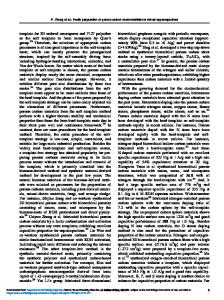Carbon Nanomaterials for Applications on Supercapacitors
- PDF / 875,386 Bytes
- 7 Pages / 612.12 x 792.12 pts Page_size
- 75 Downloads / 511 Views
Carbon Nanomaterials for Applications on Supercapacitors Youning Gong1, Qiang Fu1,2, Chunxu Pan 1,2, * 1 School of Physics and Technology, and MOE Key Laboratory of Artificial Micro- and Nano-structures, Wuhan University, Wuhan, 430072, China 2 Center for Electron Microscopy, Wuhan University, Wuhan, 430072, China ABSTRACT Supercapacitor is a newly-developed device for electrochemical energy storage with high power density, long life span, as well as rapid capture and storage of energy. Carbon-based materials, from carbon nanospheres, nanotubes and nanofibers to graphene, are the most commonly used electrode materials for supercapacitors. Our group has engaged in the research of carbon nanomaterials over the past decade. Herein we summarize some typical carbon nanomaterials and their synthetic routes based on our published works, which is expected to provide the theoretical and experimental basis for further applications on carbon-based energy storage devices. INTRODUCTION With the limited availability of fossil fuels and worldwide environmental pollution problems, there has been an increasing and urgent demand for exploring sustainable pollutionfree energy storage devices. Supercapacitors (SCs), also known as electrochemical capacitors or ultra-capacitors, exhibit both high capacitance and large energy density, which bridge the gap between conventional capacitors and rechargeable batteries, and have advantages in applications, such as portable electronics, electric vehicles and other high-power demand fields [1,2]. Based on the energy storage mechanism, SCs are usually classified into two categories: 1) electrochemical double layer capacitor (EDLC), and 2) redox supercapacitor or pseudocapacitor [3,4]. For EDLC, the capacitance was provided by the pure electrostatic charge accumulated at the electrode/electrolyte interface. The energy storage is intrinsically fast, because it only involves movement of ions on electrode surfaces, and it greatly depends on the surface area and conductivity of the electrode materials, which is accessible to the electrolyte ions. On the other hand, the reversible Faradaic-type charge transfer occurs in pseudocapacitor, and the capacitance is associated with an electrochemical charge-transfer process that takes place on the available surface of the active material. To develop high-performance SCs, the pseudocapacitance is always coupled with EDLC to enhance the overall capacitance of the electrode material due to the presence of foreign electro-active species in the porous carbon frame work. It is obvious that the mechanisms of both EDLC and pseudocapacitor are surface phenomena during the charge-discharge processes, and thus the performance is strongly dependent on the microstructures and conductivity [5]. As a key component of SCs, electrode materials mainly determine the overall electrochemical performance of a supercapacitor [4]. It is well-known that carbon-based materials are the most commonly used electrode materials for their advantages including low
Downloaded from https:/www.
Data Loading...











